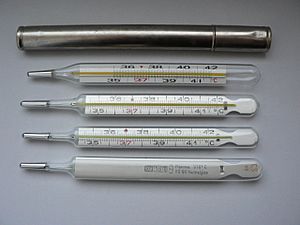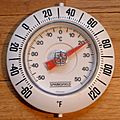Thermometer facts for kids
A thermometer is a tool that measures how hot or cold something is. This is called temperature. Some thermometers are glass tubes with a liquid inside, like alcohol or mercury. This liquid moves up or down as the temperature changes. Other thermometers are digital. They use electronics to measure temperature.
The first thermometers were made around the time of Galileo. They measured how much air expanded or shrank. Later, in the 1600s, people started using alcohol or mercury in thermometers. In the 1800s, a new type was invented. It used a special metal strip that bent with temperature changes. This moved a pointer. These are still popular for reading temperatures from a distance.
Contents
How Lab Thermometers Work
A laboratory thermometer is a special tool. Scientists use it in labs to measure temperature very accurately. You can put it partly or fully into the substance you want to measure. Lab thermometers have a long stem and a silver bulb at the end. The silver color usually means it contains mercury.
When it gets hotter, the mercury expands and moves up the tube. This shows a higher temperature. When it gets colder, the mercury shrinks and moves down. Today, mercury thermometers are used less often. Labs now prefer digital, alcohol, or other types of thermometers.
Medical Thermometers for Health
In the 1900s, a common medical thermometer was a glass one with mercury inside. People would put it in their mouth (oral temperature), under their arm, or in their rectum (rectal temperature).
Oral thermometers work best for people who can hold them still in their mouth. This means young children cannot usually use them. They are also not good for people who are coughing or vomiting. Old mercury thermometers took a long time to get a reading. Modern digital thermometers are much faster. If someone drinks something hot or cold, they need to wait before checking their oral temperature.
When taking a rectal temperature, it helps to use a cream on the thermometer. Rectal temperatures are often more accurate. This is because other things don't affect them as much. In some places, people feel shy about using them for older children or adults. In other places, it is normal for both children and adults.
In the 1990s, many countries stopped using mercury thermometers. This was because mercury is dangerous if it leaks out. Now, we mostly use electronic thermometers. Some liquid thermometers are still used, but they do not contain mercury.
There are other kinds of medical thermometers too:
- Tympanic thermometers measure the temperature of the tympanic membrane (eardrum). They use infrared light.
- Band thermometers are placed on a person's forehead to check temperature.
Different Kinds of Thermometers
- Liquid-in-glass thermometer
- Mercury-in-glass thermometer
- Alcohol-in-glass thermometer
- Clinical thermometer
- Digital thermometer
- Rotary thermometer
- Resistance thermometer
- Liquid crystal thermometer
- Infra-red thermometer
Images for kids
-
A thermometer showing Fahrenheit (°F) and Celsius (°C) units.
-
A mercury thermometer for measuring room temperature.
-
Daniel Gabriel Fahrenheit. He created the first widely used, accurate mercury-in-glass thermometer and the Fahrenheit scale.
See also
 In Spanish: Termómetro para niños
In Spanish: Termómetro para niños












